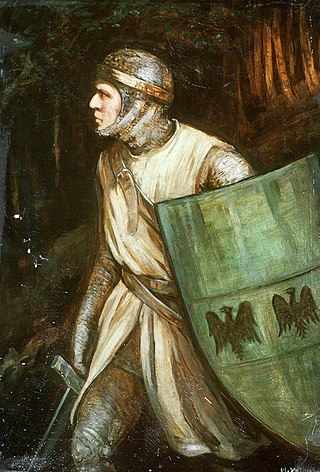Related Research Articles
Llywelyn ab Iorwerth, also known as Llywelyn the Great, anglicised as Leolinus Magnus, was a medieval Welsh ruler. He succeeded his uncle, Dafydd ab Owain Gwynedd, as King of Gwynedd in 1195. By a combination of war and diplomacy, he dominated Wales for 45 years.

Owain ap Gruffudd was King of Gwynedd, North Wales, from 1137 until his death in 1170, succeeding his father Gruffudd ap Cynan. He was called Owain the Great and the first to be styled "Prince of Wales" and the "Prince of the Welsh". He is considered to be the most successful of all the North Welsh princes prior to his grandson, Llywelyn ab Iorwerth. He became known as Owain Gwynedd to distinguish him from the contemporary king of Powys Wenwynwyn, Owain ap Gruffydd ap Maredudd, who became known as Owain Cyfeiliog.

Rhodri ap Merfyn, commonly known as Rhodri Mawr, was a Welsh king whose legacy has impacted the history of Wales. Rhodri rose to power during a tumultuous era, where the fate of Welsh kingdoms was often determined by the power of their leaders.

Gruffudd ap Cynan was King of Gwynedd from 1081 until his death in 1137. In the course of a long and eventful life, he became a key figure in Welsh resistance to Norman rule.

The Kingdom of Gwynedd was a Welsh kingdom and a Roman Empire successor state that emerged in sub-Roman Britain in the 5th century during the Anglo-Saxon settlement of Britain.

The Kingdom of Powys was a Welsh successor state, petty kingdom and principality that emerged during the Middle Ages following the end of Roman rule in Britain. It very roughly covered the northern two-thirds of the modern county of Powys and part of today's English West Midlands. More precisely, and based on the Romano-British tribal lands of the Ordovices in the west and the Cornovii in the east, its boundaries originally extended from the Cambrian Mountains in the west to include the modern West Midlands region of England in the east. The fertile river valleys of the Severn and Tern are found there, and this region is referred to in later Welsh literature as "the Paradise of Powys".
Cynan Dindaethwy or Cynan ap Rhodri was a king of Gwynedd in Wales in the early Middle Ages. Cynan was the son of Rhodri Molwynog and ascended to the throne of Gwynedd upon the death of King Caradog ap Meirion in 798. His epithet refers to the commote of Dindaethwy in the cantref Rhosyr. Unlike later kings of Gwynedd, usually resident at Aberffraw in western Anglesey, Cynan maintained his court at Llanfaes on the southeastern coast. Cynan's reign was marked by a destructive dynastic power struggle with a rival named Hywel ap Caradog, usually supposed to be his brother.

Merfyn Frych, also known as Merfyn ap Gwriad and Merfyn Camwri, was King of Gwynedd from around 825 to 844, the first of its kings known not to have descended from the male line of King Cunedda.
Cyngen ap Cadell or also (Concenn), was King of Powys from 808 until his death in 854 during a pilgrimage to Rome.

Hywel ap Caradog was King of Gwynedd. He rose to power following a destructive dynastic struggle in which he deposed King Cynan Dindaethwy. During Hywel's reign, Gwynedd's power was largely confined to Anglesey. It was a time of substantial territorial loss to Mercia.

The House of Gwynedd was the royal house of the Kingdom of Gwynedd, in medieval Wales. It is divided between the House of Cunedda and the House of Aberffraw, and lasted from c.401 to 1283.
This article is about the particular significance of the century 901–1000 to Wales and its people.
Nest ferch Cadell was the daughter of Cadell ap Brochfael, an 8th-century King of Powys, the wife of Merfyn Frych, King of Gwynedd.

The House of Aberffraw was a medieval royal court based in the village it was named after, Aberffraw, Anglesey within the borders of the then Kingdom of Gwynedd. The dynasty was founded in the 9th century by a King in Wales whose descendants founded the Welsh Royal Houses. The other medieval Welsh dynasties were the Royal Houses of Dinefwr, Mathrafal.

The Royal House of Mathrafal began as a cadet branch of the Welsh Royal House of Dinefwr, taking their name from Mathrafal Castle. They effectively replaced the House of Gwertherion, who had been ruling the Kingdom of Powys since late Roman Britain, through the politically advantageous marriage of an ancestor, Merfyn the Oppressor. King Bleddyn ap Cynfyn would join the resistance of the Anglo-Saxon King Harold Godwinson, against the invasion of William the Conqueror, following the Norman conquest of England. Thereafter, they would struggle with the Plantagenets and the remaining Welsh Royal houses for the control of Wales. Although their fortunes rose and fell over the generations, they are primarily remembered as Kings of Powys and last native Prince of Wales.
Angharad ferch Meurig was a 9th-century Welsh noblewoman. She was the wife of Rhodri the Great of Gwynedd, and mother of Anarawd, Cadell ap Rhodri, and Merfyn.
Gwriad ap Elidyr or Gwriad Manaw was a late-8th century figure in Wales. Very little is known of him, and he chiefly appears in the historical record in connection to his son Merfyn Frych, King of Gwynedd from around 825 to 844 and founder of the Merfynion dynasty.
References
- ↑ Maund, K. L. (1996). Gruffudd Ap Cynan: A Collaborative Biography. Boydell & Brewer. p. 84. ISBN 978-0-85115-389-6.
- ↑ Brady, Lindy (4 August 2022). The Origin Legends of Early Medieval Britain and Ireland. Cambridge University Press. pp. 151–152. ISBN 978-1-009-22565-6.
- ↑ Thornton, David E. (2003). Kings, Chronologies, and Genealogies: Studies in the Political History of Early Medieval Ireland and Wales. Occasional Publications UPR. pp. 87–98. ISBN 978-1-900934-09-1.